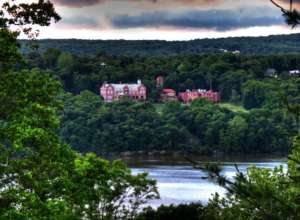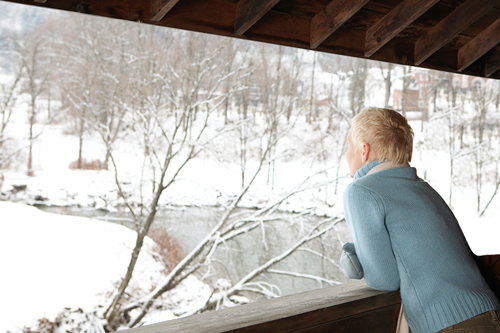 It was a blustery winter morning when I packed the car, kissed my boyfriend goodbye, and headed off for the monastery. I needed alone time without the usual distractions of life so that I could reread the latest draft of a novel I’d been working on for too many years.
It was a blustery winter morning when I packed the car, kissed my boyfriend goodbye, and headed off for the monastery. I needed alone time without the usual distractions of life so that I could reread the latest draft of a novel I’d been working on for too many years.
I’ve always struggled to balance my two lives: the public one, in which I earn my living as a book editor, and the private one I’m passionate about, my life as a writer. My number-two life had always taken a backseat to number one, which brought in the money. Although this struggle had been going on for years, I was fully dedicated to life number two, snatching bits of writing time here and there, inching along on my projects like a tortoise. Only when I found ways to set aside larger chunks of uninterrupted time for myself was I able to sink in deepest, dwell fully in the worlds I created.
I’d been to a number of artists’ colonies, amazing places that nurtured creativity. But lately I hadn’t had time for applications and waiting periods, and besides I couldn’t spend a whole month away from home. I’m self-employed and if I don’t work, I don’t earn money.
I had read about Holy Cross Monastery and, after studying its website, I called the retreat director, who assured me it was a perfect place for a writer. Their principal ministry is to guests on retreat, all denominations welcome. Plus, it was only a twenty-five-minute drive from home. I booked a stay pronto.

A few weeks later I was driving down the monastery’s long, curving driveway toward an impressive brick Tudor perched high above the western bank of the Hudson River. I parked and cautiously entered. An earthy, piney incense wafted through the halls. The place had been built in 1902 and was enormous—with two floors of monks’ cells, wide stairways, and wood everywhere. It reeked of history. I scanned the photos of monks past and present lining the walls and felt a sudden panic. I was a fraud. I’m not religious at all. Plus I’m Jewish! And the monks scared me.
I was sent upstairs to St. Titus, the name of the monk’s cell to which I’d been assigned. It was, no surprise, small and spare: a single bed, a desk, and a reading chair. But it had a stunning river view. I unpacked and looked out the window. Huge chunks of ice covered the Hudson River, creaking and cracking with the tide. A freight train chugged along the eastern bank, its whistle blowing. The radiator clanked. Except for these sounds, the quiet of the place enveloped me. I felt calmer than I had in months. This little room was all I needed. I felt I’d stumbled onto a secret gem.
Bells rang throughout the day signaling…I wasn’t sure what until I read the monastery newsletter left on my desk. Five minutes before each regularly scheduled prayer service, a bell would sound. The day began with Matins; during the morning was Holy Eucharist; at noon, they gathered for Diurnum; and the workday closed with Vespers. And there was a bell to call us for meals. I heard the muffled footsteps of people heading off to the chapel. The daily ritual was a lovely one and the bells set the rhythm for my stay.
I took my place in the dinner line with the other guests and the monks who came over from the private section of the monastery where they lived, the one place off-limits to visitors. Everyone, including the monks, was friendly. They weren’t scary at all. Although I was the only writer, I was welcomed graciously. Dinner conversation flowed. Talk of gardening, beekeeping, food, travel, and books. The monks led full, interesting lives.
But I was eager to return to St. Titus. Having nothing to do but read and write and think was my idea of Heaven, so after dinner I hurried back.
The monastery was unlike any place I’d ever been. I was definitely out of my element, but wanted to know more about the monastic way of life. Sitting at the small desk, I set my novel aside and went back to Holy Cross’s website to see what more I could glean. I came across a passage that stopped me cold:
In particular, the community holds out to us the model of a balanced life, one which integrates prayer (both liturgical and personal), work and study, and which supports each monk in living creatively the tensions and contradictions of life.
I reread the passage. The phrase “living creatively the tensions and contradictions of life” resonated. Everyone I knew juggled the pieces of his or her life. Whether they had kids and demanding jobs or no kids and no jobs, lots of money or very little, were healthy or had health issues, lived in a busy city or small town. Everyone struggled for equilibrium. Who knew that I, a nonreligious, Jewish woman, would have something in common with Episcopal monks? Just then another bell rang out. This one, I recalled from what I’d read, was the call to Compline, the night prayer completing the monastic cycle of worship, which ushered in the night silence I so cherished. I was far from alone trying to maintain balance, working as best I could, slow but steady, toward achieving a more harmonious life.
After all, it’s what I’d been doing all along. It’s what I’d keep on doing.




2 Comments
Rachel G
Get me to the monastery! Marlene’s experience makes me want to check out in order to check in, and reminds me of the importance of silence
In this noisy world.
Carol Drechsler
I love this article because it very succinctly describes what the life of a writer is all about: finding balance, harmony. Even best selling authors struggle with the need to live in the world and in their own world.
Sounds like this is one of those rare places that enables creativity in a beautiful setting and a truly inspirational environment.